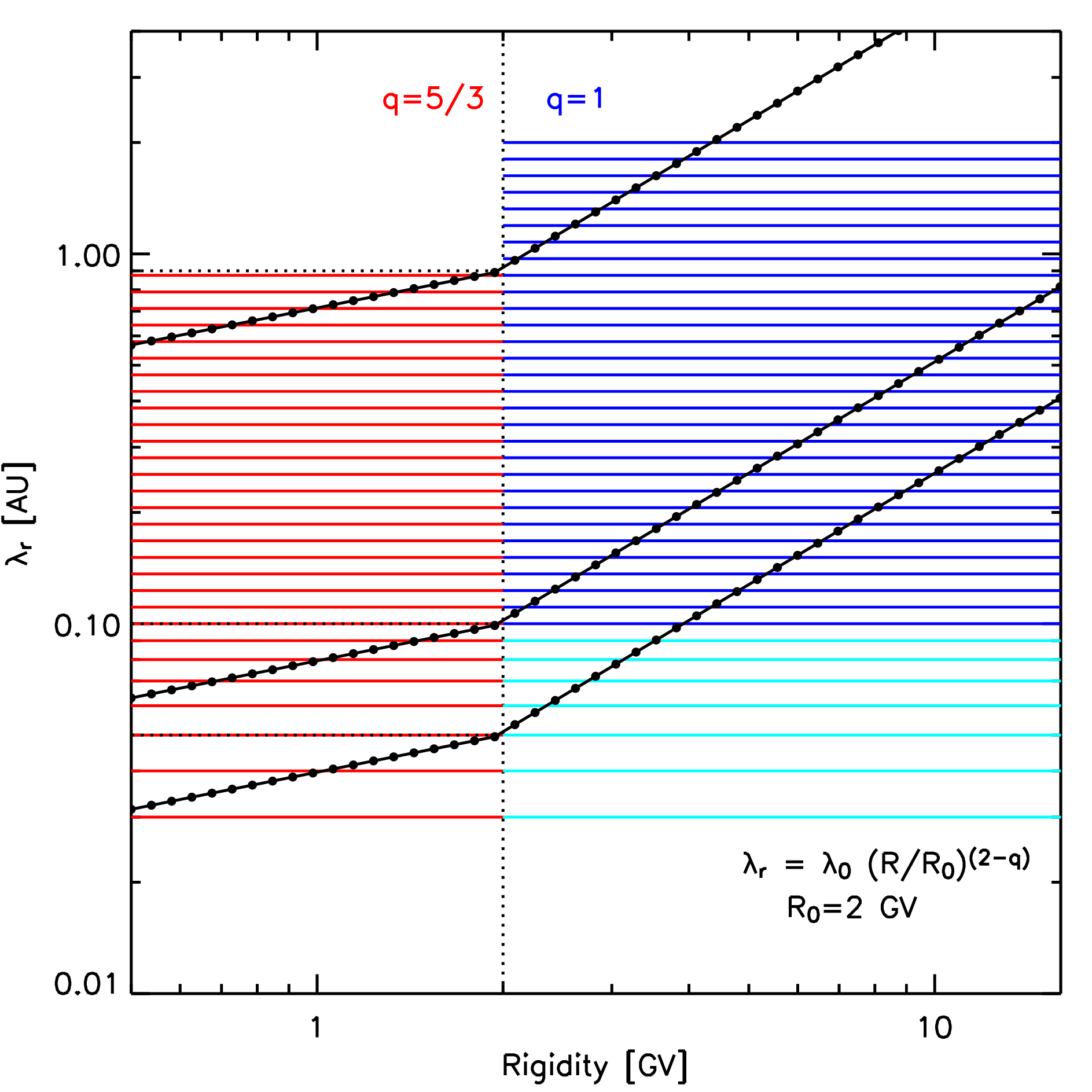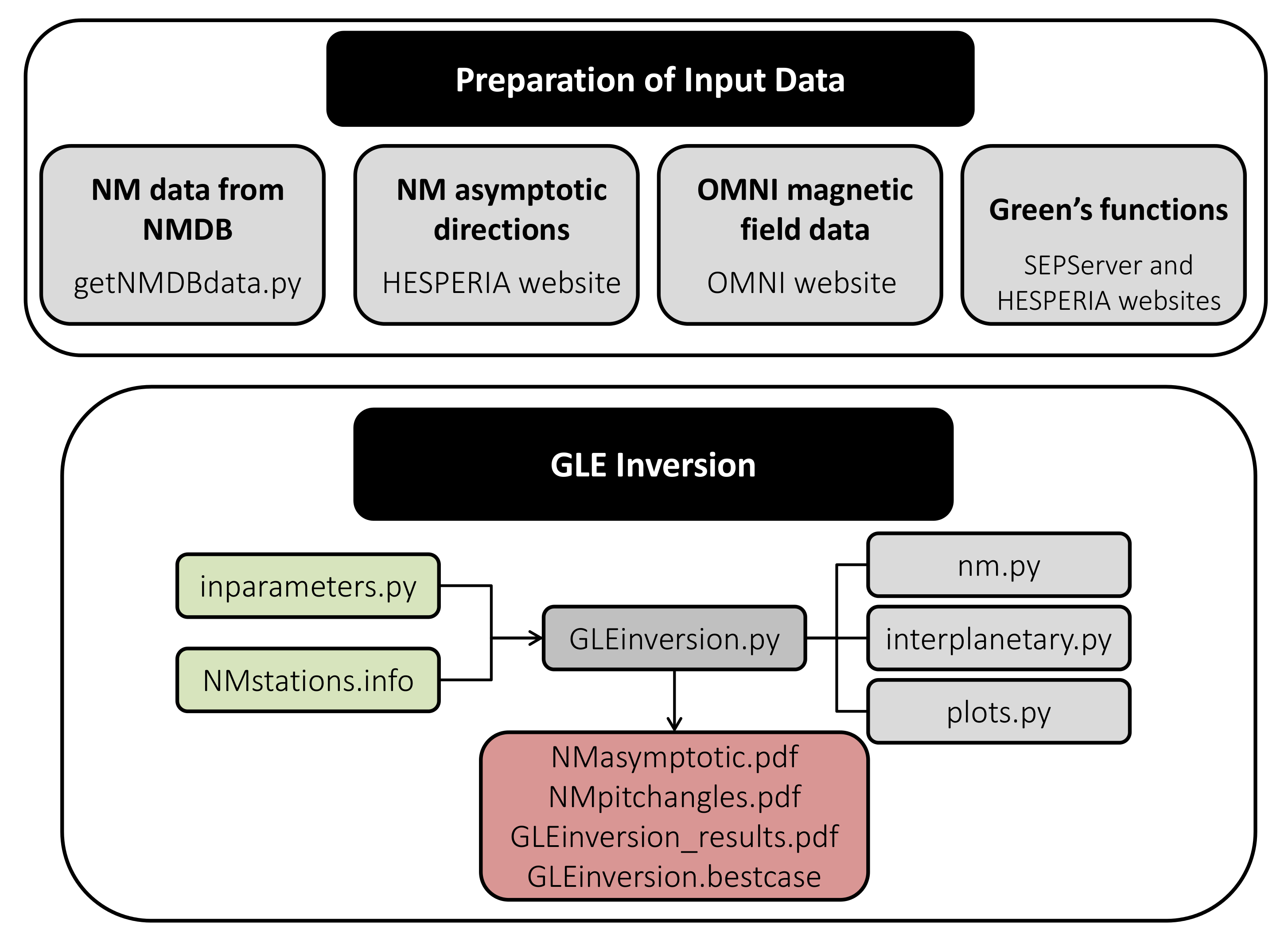The GLE inversion software was formally verified to check the correctness of the routines by running it against a specific test case.
We assumed that
- the injection profile at the Sun consisted of four consecutive release episodes of intensity [0.5,1,1,0.5]x1030 p/(s sr).
- the spectral index of the source was γ = 5, and
- the radial mean free at 2 GV λ0 = 0.1 AU.
to compute the expected relativistic proton intensities at 1 AU with the interplanetary transport model.
We then assumed a certain evolution of the interplanetary magnetic field at the Earth's bow shock and a set of NM stations with cutoff rigidities and asymptotic directions. For simplicity, we took actual the OMNI magnetic field data and the NM asymptotic directions during GLE60.
With these assumptions, we were able to compute the synthetic count rate increases for a set of NM stations.
We then inverted the synthetic NM data using the GLE inversion software. The best fit scenario assumed to create the synthetic data was successfully recovered. Check the results here.
The HESPERIA project, funded by the Horizon 2020 programme of the European Union, organises a workshop on solar energetic particle events, to be held
27 February (14:00) – 2 March 2017 (18:00)
at Paris Observatory (Paris, France)
The HESPERIA project is intended to further our ability to forecast SEP events, while also studying the general physics of high-energy particle acceleration and the relationship between SEPs and electromagnetic radiation of particles interacting in the solar atmosphere. The public project web site is http://www.hesperia-space.eu .
The aim of this workshop is to present results of the HESPERIA project to a public of experts, and to discuss it with respect to other research. Key topics are
• the understanding of high-energy particle acceleration in solar eruptive events,
• observations, theory and modelling of SEP events,
• solar cycle dependence of SEPs and the related solar events,
• the development of forecasting techniques of SEP events
The workshop will be held over four days. It will consist of presentations by the HESPERIA team on research accomplished during the project and on methods and products developed for the purpose of SEP forecasting. Much time is planned to be available for discussions and brief ad-hoc presentations.
Scientists from outside the HESPERIA consortium are welcome to participate. Due to limiting space this will, however, only be possible upon invitation. Please contact the local organisers if you wish to participate and did not receive a letter of invitation so far. The organisers cannot provide financial support.
All participants are invited to propose oral contributions. Please send a title and an informal abstract by e-mail to the organisers: This email address is being protected from spambots. You need JavaScript enabled to view it..
Deadline: 31 January 2017.
GLE inversion software package
The software is currently available in a beta version. If you are a member of the HESPERIA consortium, you can access the beta version through ownCloud. If you are an external user and you are interested in this version please email us.
Download NM Asymptotic Directions
The asymptotic directions for all neutron monitor stations for all historic GLEs, from GLE 1 through 71, were computed using the software suite PLANETOCOSMICS (Desorgher et al. 2006). The geomagnetic field is described by the IGRF model for the magnetic field contributions caused by sources in the Earth's interior and the Tsyganenko 1989 model (Tsyganenko 1989) describing the magnetic field caused by current systems within the geomagnetosphere. The asymptotic directions were calculated every 15 minutes for all neutron monitor stations.
The list of GLEs was taken from NMDB.
The values of the Kp index were obtained from NOAA (before 1994) and from the Helmholtz-Centre Potsdam (after 1994).
Download: asymptotic.tar (370 MB)
Download Interplanetary Green's Functions for Relativistic Particles
SEPServer hosts a database of Green's functions of interplanetary transport computed for relativistic particles propagating at the speed of light to aid the studies of GLEs. This database was computed assuming 30 values of the proton radial mean free path logarithmically spaced between 0.10 and 2.00 AU and 10 values of the solar wind speed between 300 and 750 km/s, with step intervals of 50 km/s. The pitch-angle diffusion coefficient was assumed isotropic with q = 1 (see Used Models).
We computed a new database of results assuming a pitch-angle diffusion coefficient that considers the case q=5/3, in order to be able to model the propagation of low-rigidity (< 2 GV) protons mostly (see Used Models). The database was computed assuming 29 values of the electron radial mean free path between 0.03 and 0.90 AU and 10 values of the solar wind speed between 300 and 750 km/s, with step intervals of 50 km/s. In addition, we expanded the database of results for isotropic scattering (q = 1) to include mean free path values lower than 0.10 AU.

Download: greens.tar (270 MB)
The software has been tested on Linux systems, Mac OS, and Windows.
Linux distributions
- openSUSE 13.1 (Bottle) (x86 64)
It is not possible to install python-matplotlib versions after 1.30-3.1.3. However, with python-matplotlib version 1.30-3.1.3 it is not possible to make plots on multiple pages as pdf. It can be expected that the GLE inversion software runs on openSUSE versions higher than version 13.1.
- Ubuntu 16.04 LTS
works fine, only the Python libraries scipy and numpy have to be installed manually.
Mac OS
- OS X Yosemite
works fine. The libraries numpy, spicy and matplotlib have to be installed manually.
- Windows 7
Windows
To run this software, the user needs to consider two main blocks. The first one concerns the storage of the data needed for the GLE inversion. This includes NM data, the computed asymptotic directions of the NM stations, the OMNI magnetic field data in GSE coordinates and a database of results of an interplanetary transport model. The second block requires these data to invert the problem and infer from the measured NM relative increases the characteristics of the solar source (injection profile and spectral index) and the interplanetary transport conditions.

Preparation of Input Data
- Run the program getNMDBdata.py to directly download 5-min NM data from the Neutron Monitor Data Base (NMDB) to the user’s computer by using the NMDB Nest tool. The time interval, i.e. start and end time, during which the NM data should be downloaded has to be given in the first lines of the program code.
- Download the computation results of the cosmic ray particle trajectories in the geomagnetic field, i.e. the asymptotic directions of the NM stations for the selected time of the GLE under investigation. Download them from here. It is required that the asymptotic directions are in Geocentric Solar Ecliptic (GSE) coordinates. In principle, users of the GLE inversion software are free to determine the asymptotic directions for the selected NM stations and for the selected date and time by using e.g. different models for the Earth's magnetic field. That goes without saying that the self generated files must have the same format.
- Download annual 5-min OMNI interplanetary magnetic field data in GSE coordinates from the OMNI database. The OMNI database provides a well-documented dataset of time-shifted magnetic field observations, which describe the field evolution at the nose of the Earth’s bow shock as a function of time. The GLE inversion software uses the magnetic field vector to compute the pitch angles observed by each NM station, i.e. the angle between the magnetic field direction and the asymptotic directions of each NM station. The interplanetary magnetic field data is averaged over a 30 min time window.
- Download the Green’s functions of the interplanetary transport, which are the results of an interplanetary transport model that simulates the propagation of relativistic solar energetic particles along the interplanetary magnetic field. Adiabatic deceleration in the interplanetary space as well as effects of diffusion perpendicular to the average magnetic field and drifts are neglected in the interplanetary transport model. In addition, it is assumed that there is no variation across the magnetic field and that respective solutions are identical in neighboring flux tubes. One of the limitations of this database is, that it is not useful for the study of particle events showing bidirectional pitch-angle distributions. The database of Green’s functions is available in SEPServer and in the HESPERIA website.
GLE Inversion
The GLE inversion software consists of 6 files:
- GLEinversion.py: This is the main program. To run the GLE inversion program the user needs to type python GLEinversion.py in the terminal.
- nm.py: It is a module required by the main program. It contains functions to read NM data and the asymptotic direction files, and to compute the simulated relative NM count rate increases.
- interplanetary.py: It is a module required by the main program. It contains functions to read the Green's functions of interplanetary transport, the OMNI magnetic field and handle its averaging, and perform the inversion of the problem.
- plots.py: It is a module required by the main program. It contains functions to plot the results determined by the software.
- inparameters.py: It is the file with the input parameters used by the software where the user needs to specify:
- the beginning and end of the fitting period (Note it is limited to 3 h),
- the start and end time of the baseline interval, i.e. a time interval before the GLE to determine the count rate caused by the actual galactic cosmic ray intensity, usually the full hour before the onset of the GLE is used,
- where in his/her computer the relevant data is stored. This includes: directory where the NM data files are located, the directory with computed NM asymptotic directions, the directory with the 5-min OMNI magnetic field data, the directory with the Green’s functions of interplanetary transport,
- the interplanetary magnetic field polarity (+1 or -1). The IMF polarity can be inferred by inspecting the pitch-angle distributions of suprathermal electrons measured by e.g. ACE. These plots also provide information about whether the Earth is in an open/closed field line configuration,
- the range of values of the proton mean free path at rigidity 2 GV (λ0) that the user would like to test. Note that the software can properly handle values between 0.05 and 0.9 AU only,
- the range of values of the spectral index of the solar source spectrum (dN/dR = R-γ) that the user would like to test.
- NMstation.info: This ASCII file contains relevant information about each NM station such as: NM short name, NM full name, geographic latitude and longitude of the NM station, altitude of the NM station, reference pressure of the NM station, barometric coefficient of the NM station, number of counter tubes and cutoff rigidity of the NM station.
In addition, the GLE inversion software makes use of the following Python libraries and modules: numpy, scipy, matplotlib, os, datetime and bisect.

 hesperia [dot] info [at] hesperia-space [dot] eu
hesperia [dot] info [at] hesperia-space [dot] eu










